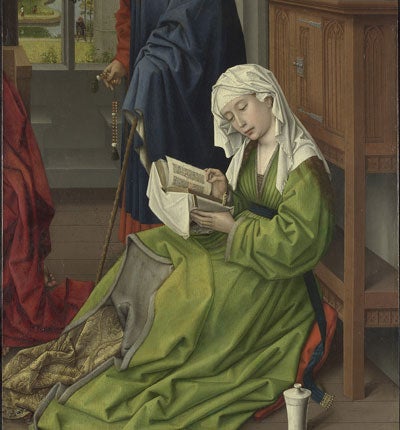Rogier van der Weyden: Master of Passions, Museum Leuven, Belgium
Rogier's poster girl more than makes up for absent friends

The Leuven Museum's reopening show, Rogier van der Weyden: Master of Passions, is made up of a number of absences and a single great presence, the last being Rogier himself, one of the few artists who can unhesitatingly be said to have changed the way we see the world. It is the absences, though, that allow us to see the miraculousness of Rogier, the 15th century's painter of miracles.
Consider the exhibition's poster girl, The Magdalen Reading. On loan from the National Gallery in London, the Magdalen seems self-contained as she sits lost in her book, her louche past hinted at by the nap in the fur lining of her dress, the hair that escapes from her veil. Even her fingers, absent-mindedly circled, suggest completeness. In her mix of purity and eroticism, Rogier's Magdalen feels whole; but she isn't.
To her left, protruding from under a red robe, are toes – as it happens, those of Saint John the Evangelist, long ago cut from the altarpiece of which the London Magdalen was once a part. The decapitated man behind her is St Joseph, his body here reunited with its head, now in a Lisbon museum. There may be other missing saints, too. If the contemporary drawing of a lost Rogier altarpiece by the Master of Girart de Roussillon is this altarpiece, then John the Baptist and an unnamed bishop were also part of the sacra conversazione, that emotional grouping of saints with the Madonna and Child which Rogier made his own. Sometime between the altarpiece's completion before 1438 and the sale of The Magdalen Reading from the collection of a man named Cassino in 1810, the panels were cut and their parts sold; a depressingly familiar story in Van der Weyden's career.
And yet, this destruction tells us something of the almost religious esteem in which Rogier was held by his fellows. Like the teeth and knuckle-bones of the saints he painted, the artist's relics were things to be fought over. A century after he finished it, Rogier's Descent from the Cross, now in the Prado, was in the palace of Mary of Hungary. Seeing it there, one Hapsburg courtier remarked that Michelangelo himself might have painted it. Another, Vicente Alvarez, went one better and claimed the picture as the best in the royal collection, "and even, I believe, in the whole world". The Descent is also absent from this show, together with such great Rogiers as The Last Judgement altarpiece in Beaune. Almost six centuries after they were painted, these works aren't so much too fragile to travel as too treasured, the thought of their loss or damage even now impossible to contemplate.
Making a virtue of absence calls for real skill, and this brilliant show has it in spades. Without over-egging their case, its curators raise the central question of Renaissance art history: whether the main current of influence between Italian and Netherlandish painting ran south to north or the other way. One of the greatest absences is also one of the oldest, the monumental panels made by Rogier for the new town hall of Brussels in the 1430s and burned when Louis XIV's invading armies bombarded the city in 1695. Like so much of his work, the panels are known only from copies – here, tapestries commissioned by the Bishop of Lausanne in the early 1440s. These seem recognisably Italianate, influenced perhaps by Benozzo Gozzoli's Magi paintings in the Palazzo Medici in Florence. Actually, it was Benozzo who was Rogierian, not Rogier Italianate.
Something of the scale of the master's influence is hinted at by the number of times the Flemish words "naar" and "navogel" – "after" and "follower of" – appear in signage to this show. By the time of his death in 1464, Rogier's hand was everywhere, and not just in painting. The couple leaning over a parapet in St Luke drawing the Virgin – naar Rogier – reappear, half a century later, in a Brussels tapestry. The illuminated Virgin and Child in the Grimani Breviary are also Rogierian, as are the four stone-carved Apostles in Room 5 and the wooden Calvary group from a church at Bierghes. The floating loincloth of the crucified Christ is pure Rogier: we see it later in Florentine painting, most famously in Botticelli. Of Rogier himself, there is only a great mystery – a portrait engraving made a century after his death, the workshop picture of an ageing couple thought to be the master and his wife. And then there is the work: the incomparable pathos and beauty of Rogier's vision, the magnificent subject of this unmissable show.
M van Museum, Leuven, Belgium (0032 16 20 09 09) to 6 Dec
Subscribe to Independent Premium to bookmark this article
Want to bookmark your favourite articles and stories to read or reference later? Start your Independent Premium subscription today.

Join our commenting forum
Join thought-provoking conversations, follow other Independent readers and see their replies